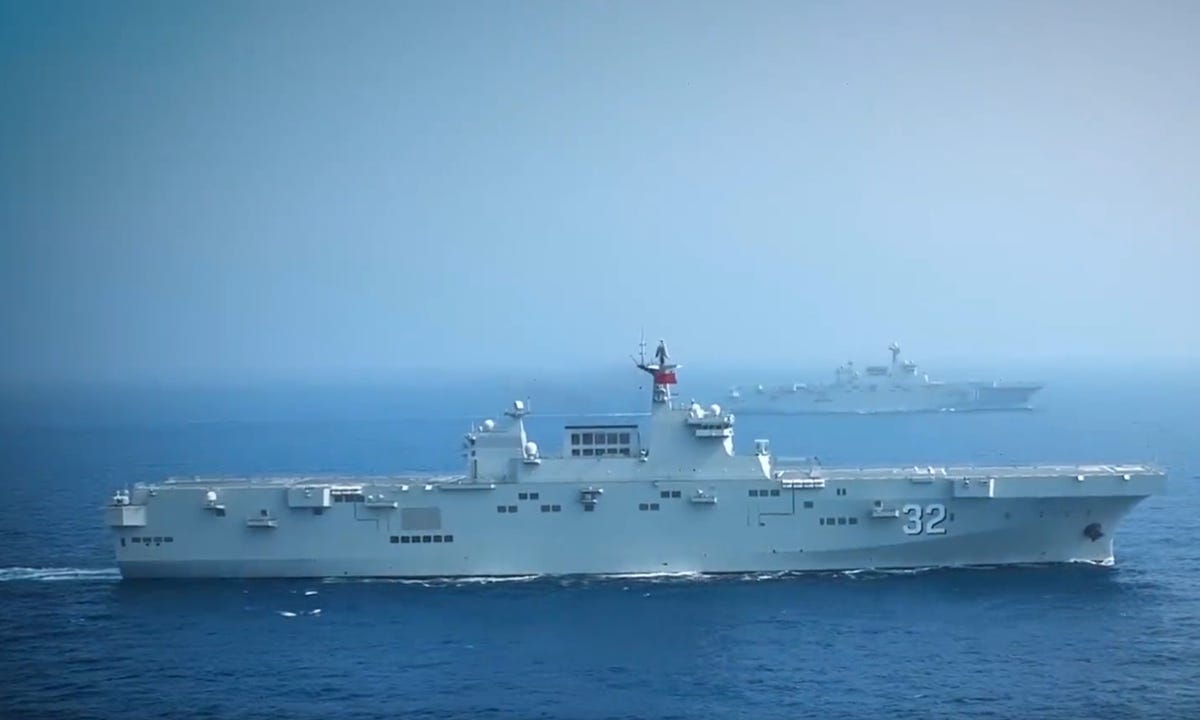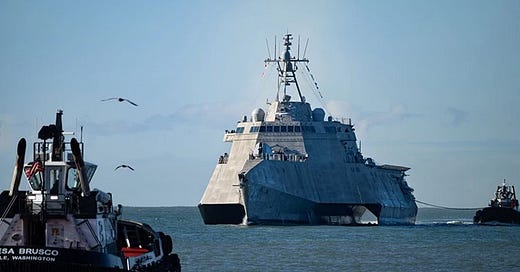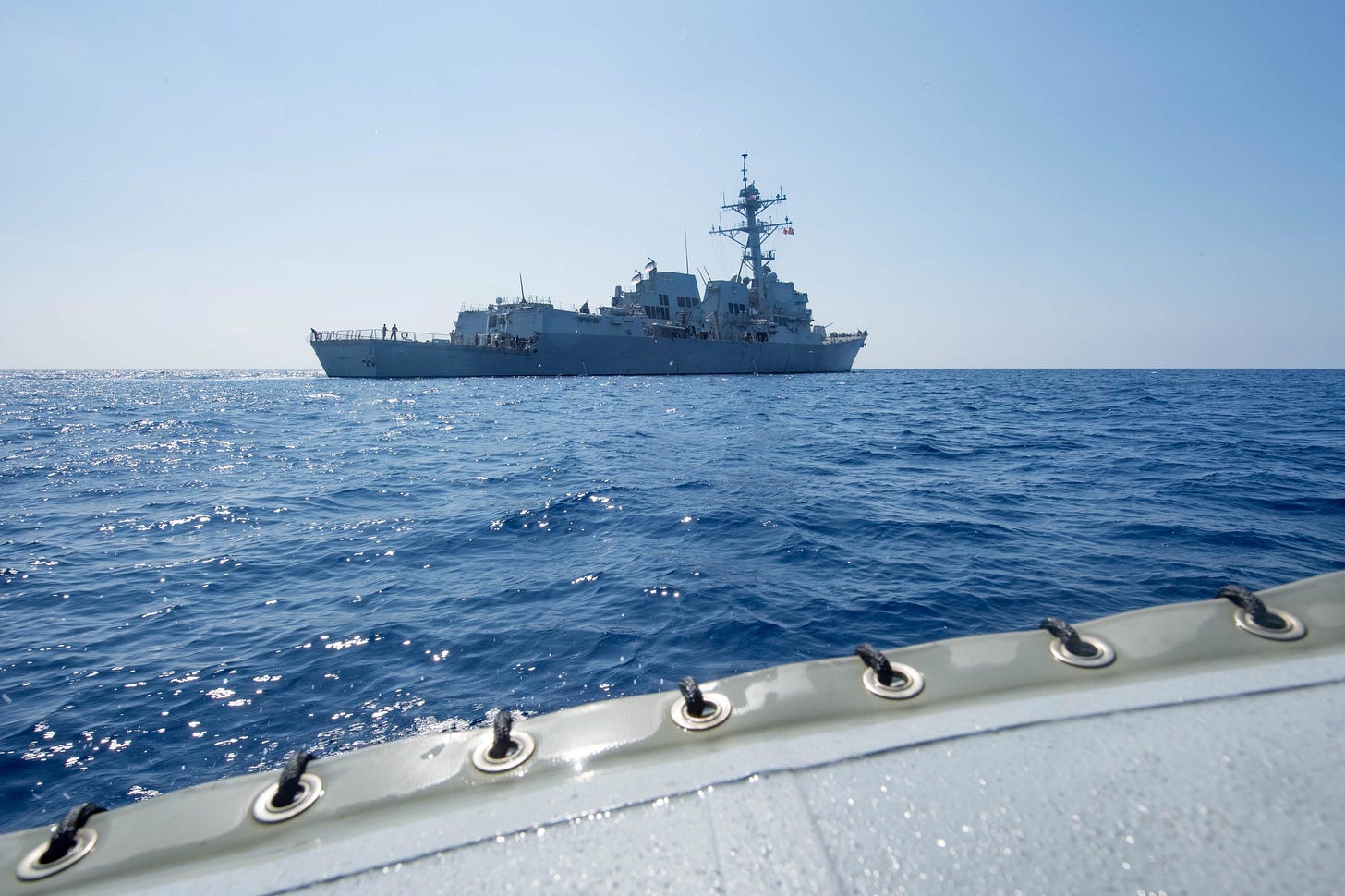US Warship Docks in Cambodia
US warship visit provides chance to silence Ream base critics, PLA Navy's Type 075 amphibious assault ship to visit Hong Kong for 1st time, Stretched US Navy eyes risky new waters in South China Sea.
US warship visit provides chance to silence Ream base critics
According to the Ministry of National Defence, the USS Savannah will dock at the Sihanoukville Autonomous Port (PAS) today on a goodwill mission to the Kingdom.
A press release on Friday said that during the five-day port call, the ship’s delegation has planned a series of activities to promote cultural exchange and cooperation.
It noted that these activities include a working meeting with the commander of the Ream Naval Base, a meeting with the leaders of the Preah Sihanouk provincial administration, a friendly sports competition between the crews of the US warship and the Cambodian Navy to promote camaraderie and teamwork, as well as several other friendly programmes.
The Defence Ministry said that the USS Savannah, an independence-class littoral combat ship with a crew of 103, will be the first US naval vessel to visit Cambodia after eight years.
It noted that since 2007, a total of 27 US Navy warships had previously visited Cambodia.
The ministry stated that the purpose of this visit is to strengthen and expand the friendship and enhance bilateral cooperation between Cambodia and the United States.
The ministry emphasised that the visit marks an important milestone in the growing partnership between Cambodia and the United States.
To a question from Khmer Times, Defence Ministry spokeswoman Maly Socheata was unable to provide information on whether the US sailors would visit Ream Base.
Socheata previously stated that Cambodia always welcomes all parties willing to sincerely and genuinely assist in the national defence sector. She noted that Cambodia has established development partnerships in training, education, and providing military equipment to support the sector.
She reiterated that Cambodia, as a sovereign state, has the right to build and promote cooperation with all partners to serve the interests of the country and its people. All such cooperation is in line with the objectives and principles of the Cambodian constitution, particularly the respect for and protection of sovereignty, territorial integrity, and independence.
Yang Peou, Secretary-General of the Royal Academy of Cambodia, said that the docking of the US warship symbolises the goodwill of mutual cooperation, which had been suspended for eight years. This visit also follows the re-establishment of cooperation following the visit of US Secretary of Defense Lloyd James Austin III in June 2024.
Peou noted that Cambodia-US cooperation will continue in the defence sector and other key areas. He called on both countries to cooperate fully to foster mutual understanding and support global interests and order. Although Cambodia is a small country, it is part of the global order, which requires the involvement of all nations.
Peou emphasised that even though Cambodia is currently at peace, maintaining strong relations with relevant partners in the defence sector is necessary. Cambodia’s geographical position, with both land and maritime borders, requires robust defence capabilities, especially as neighbouring countries are also developing their own military sectors.
He added by stating that if Cambodia maintains good relations with countries like the United States, China, Japan, and other defence partners, it will be better positioned to defend its sovereignty.
Therefore, Cambodia must develop its military technology, capabilities, and national defence capacity, recognising that a strong defence leads to greater peace and development.
Seun Sam, a policy analyst at the Royal Academy of Cambodia, noted that although the US warship will dock at the PAS, this may not be enough to dispel accusations or suspicions from some countries that the Ream Naval Base will be used for Chinese naval vessels.
He said this is part of the geopolitical competition and the US does not want Cambodia to be overly close to China.
He said, “We must acknowledge that this issue has been ongoing for years, with global media and certain countries spreading the narrative that Cambodia’s Ream Naval Base will eventually be used by China, a claim often mentioned by the United States.”
Sam added that the bilateral meetings between US and Cambodian sailors may not entirely erase these doubts. While the meetings are a positive step, interpretations of them may differ.
Nonetheless, Sam praised the Cambodia-US military dialogue as a good opportunity to reaffirm to the US that the Ream Naval base is a Cambodian facility. Whether the US accepts this is up to them, but Cambodia has made its position clear.
He also reiterated that the Cambodian government has consistently stated that the Ream base belongs to Cambodia and is located on Cambodian soil. Particularly, Article 53 of the Cambodian constitution states that the Kingdom of Cambodia does not allow foreign military bases on its territory, nor does it send troops to other countries, except for UN peacekeeping operations.
Sam argued that while Cambodia has good relations with any country, it should not be perceived as aligning only with China or the United States. Cambodia must maintain balanced relations with all countries, including China, the United States, Australia, Japan, South Korea, and others. This balance is crucial for Cambodia’s diplomatic and economic interests, especially considering the US market is one of Cambodia’s largest.
https://www.khmertimeskh.com/501608627/us-warship-visit-provides-chance-to-silence-ream-base-critics/

PLA Navy's Type 075 amphibious assault ship to visit Hong Kong for 1st time
By Liu Xuanzun (Global Times)
The Chinese Defense Ministry announced on Tuesday that a Chinese People's Liberation Army (PLA) Navy formation, including a Type 075 amphibious assault ship, is set to visit Hong Kong on Thursday.
It will be the first Hong Kong call by a PLA Navy amphibious assault ship, and military expert Song Zhongping said that the visit is an important opportunity of national defense and patriotic education.
With the approval of the Central Military Commission and according to an annual work plan, a formation consisting of the PLA Navy'sHainanandChangshais scheduled to visit Hong Kong from November 21-25 and host a series of open-door events for Hong Kong and Macao compatriots, according to a statement by the Chinese Defense Ministry.
The goal of the events is to showcase the achievements of national defense and military development in the new era, and display the PLA's firm determination and strong capabilities in safeguarding national sovereignty and security, the Chinese Defense Ministry said.
Stressing the significance of national defense and patriotic education highlighted by the visit, Song told the Global Times on Tuesday that Hong Kong is an international city that occasionally hosts port calls by warships from foreign countries, including US aircraft carriers in the past. He said that with the constant development of the Chinese military, the visit by advanced PLA Navy equipment will contribute to Hong Kong residents' national identity.
In July 2017, the PLA Navy's first aircraft carrier, theLiaoning, among other warships, visited Hong Kong and opened to the public, the PLA's official website 81.cn reported at the time.
Song, who boarded theLiaoningat that occasion, said that many people applied to board the carrier, and the crowd waved Chinese national flags in their hands.
The two warships to visit Hong Kong this time are very representative of the PLA Navy's rapid development in recent years, according to Song.
The Hainan is the PLA Navy's first Type 075 amphibious assault ship, and the Changsha is a Type 052D guided missile destroyer, according to previous reports by China Central Television (CCTV).
This marks the first visit of a PLA Navy amphibious assault ship to Hong Kong since the Hainan was launched in September 2019 and commissioned into the PLA Navy in April 2021.
Capable of carrying a large number of helicopters on its flight deck, amphibious assault ship is a genre of large warship only second to aircraft carrier, while the Type 052D is the latest version in China's Type 052 destroyer series, Song noted.
The PLA Navy displayed Z-20J shipborne utility helicopters and Z-8C shipborne transport helicopters at the Airshow China 2024, which just wrapped up on Sunday in Zhuhai, South China's Guangdong Province.
Military expert Zhang Junshe told the Global Times that these two types of helicopters can carry marines and conduct airborne amphibious assault missions from Type 075 amphibious assault ships and Type 071 dock landing ships.
The helicopters can fly over obstacles on the beach, and land directly behind the enemy defense lines, Zhang said.
https://www.globaltimes.cn/page/202411/1323387.shtml
Stretched US Navy eyes risky new waters in South China Sea
By Peter Apps (Reuters) (dates amended)
As two U.S. aircraft carrier battle groups patrolled the Indian Ocean in an explicit effort to deter Iran from striking Israel and sparking a major regional conflict, a very different military messaging effort was underway in a luxury conference centre in Manila.
The 35th annual Military Law and Operations Conference organised by the U.S. Indo-Pacific Command – running from Aug. 27-30 – is held every year in a different country in the region – but its presence in the capital of the Philippines in August was likely far from a coincidence.
Since late 2023, supply ships from the Philippines have had to run a gauntlet of Chinese patrol boats trying to block them from accessing the disputed Second Thomas Shoal, home to grounded Filipino landing craft the BRP Sierra Madre.
In June, a Filipino marine lost his thumb during a collision with a Chinese vessel in a violent face-off involving Chinese military personnel waving clubs and spears.
More recently, a second and perhaps equally dangerous confrontation has erupted over the nearby Sabina Shoal, where the largest ship in the Philippine Coast Guard, the BRP Teresa Magbauna, has been anchored since April.
The last month has seen at least two collisions between Chinese patrol ships and Philippine vessels resupplying the Teresa Magbauna, while the Philippines has also accused Chinese aircraft of flying dangerously close to maritime patrol planes.
As the conference opened on Tuesday, the commander of the U.S. Indo-Pacific Command, Admiral Samuel Paparo, said the U.S. was now considering accompanying vessels from the Philippines to resupply both disputed shoals - a move that Beijing would almost certainly see as a major escalation.
"Escort of one vessel to the other is an entirely reasonable option within our Mutual Defence Treaty, among this close alliance between the two of us," Paparo told a joint press conference with Philippines General Romeo Brawner, referring to a 1951 treaty that commits Washington to supporting Manila in the event of an armed attack on its forces.
Beijing’s intent, officials in Washington and the Philippines both suspect, is to drive Philippines forces permanently - ideally this year - from both Second Thomas and Sabina Shoals by making it impossible for them to mount resupply missions.
Both Manila and Washington appear united in their determination that the Philippines should not be forced to abandon either shoal.
Previous eras might have seen an aircraft carrier pulled from its station on the far side of the world to show the flag in the South China Sea.
In these more contested times, the U.S. effort might be rather smaller: perhaps a frigate or destroyer sailing alongside their Filipino counterparts, or even just using U.S. helicopters to take supplies to the two beleaguered Filipino vessels.
According to the independent U.S. Naval Institute, the U.S. amphibious assault ships Boxer and America are currently conducting exercises and operations off Japan and the Philippines respectively.
Currently, however, the U.S. Navy does not have a single aircraft carrier anywhere in Asia, the first time that has been the case since 2001.
U.S. officials say that is just a short-term situation – the previously Japan-based Nimitz-class USS Ronald Reagan is now being swapped for her sister ship George Washington, while aside from the two carriers in the Middle East, the others are engaged in refits or training on the U.S. Atlantic or Pacific coasts.
SETTING PRECEDENT, PERCEPTION
The Biden administration has gone out of its way to give the impression that it would respond militarily to any attack on Taiwan. However, Beijing would likely see a ready surrender of the two Filipino outposts in the South China Sea as a wider signal of weak U.S. resolve.
Most recently, the Philippines Coast Guard was forced to abandon a resupply run to Sabina Shoal on Monday after its vessels were intercepted aggressively by Chinese counterparts.
Over the last decade, successive Manila governments have periodically announced deals with Beijing over access to Second Thomas Shoal, only for confrontations to resume shortly after.
"We can't afford to ignore this sort of thing, because eventually it sets precedent and shapes perception," said Samuel Byers, a former Pentagon official and now senior adviser at the Center for Maritime Strategy in Washington DC. "That kind of sets the mindset of both allies and adversaries."
U.S. officials say they believe Chinese President Xi Jinping is still considering whether or not to use military force to invade Taiwan but has ordered his military to be prepared to do so by 2027.
The problem, Byers said, is that simultaneous crises elsewhere in the world – currently particularly the Middle East – are leaving U.S. forces looking overstretched.
U.S. Defense Secretary Lloyd Austin this week ordered the two U.S. carriers already in the Middle East to extend their deployments further, described by a Pentagon spokesman as a “clear signal” the U.S. stands behind the defence of Israel.
That show of force seems to have been effective – on Wednesday, the chairman of the U.S. Joint Chiefs of Staff, Air Force General Charles Brown, told Reuters both Iran and Israel appeared to have found “off ramps” from a face-off, which intensified sharply following the assassination of Hamas political leader Ismail Haniyeh in Tehran on July 31.
In a measure of the need to make tough choices, however, Washington has scaled back forces it had kept in the Red Sea since late 2023, when the USS Eisenhower carrier battle group spent months knocking down drones and rockets fired from Yemen by Iran-backed Houthi militants. In the process, the battle group used up more Tomahawk land attack missiles than the U.S. military purchased in the whole of 2023.
The Houthi attacks, however, have continued, with U.S. warships now no longer nearby but instead in positions from which they can strike Iran directly in the event of any wider war.
A smaller force of European warships remains to assist commercial vessels in the Red Sea, one of which – the Greek tanker MV Sounion – was this week reported ablaze and leaking oil, with salvage efforts complicated by threats of further attacks.
LONG TIME COMING
With much merchant shipping now avoiding the Red Sea, the idea that the world’s pre-eminent naval force, the U.S. Navy, might largely abandon its campaign there would once have been unthinkable.
The fact it has done so points not just to the level of priority being given to deterring Iran from doing something rash, but also the feeling that the United States now faces a very different era.
One obvious likely casualty is U.S. support to Europe – in 2022 and 2023, U.S. aircraft carriers joined exercises with NATO forces, but none has done so in the current year. U.S. officials have become increasingly blunt that European nations should defend their own backyard, while Washington shifts its focus to the Pacific.
What is most important, U.S. officials say, is the growing “latticework” of alliances Washington has built in Asia, particularly tying Japan, South Korea, the Philippines and Australia.
For most of those countries, the confrontation with China has been a long time coming.
Over the last two decades, China has built its own outposts on several disputed islands including a major military base on the Philippine-claimed Mischief Reef.
Meanwhile, the fishing and patrol boats of its “maritime militia” now routinely stop vessels from the Philippines and other foreign craft reaching the disputed Scarborough Shoal.
A 2016 ruling by the United Nations maritime court in The Hague described much of the oil and energy-rich Spratly islands including Scarborough, Second Thomas and Sabina shoals as part of the Philippines Exclusive Economic Zone.
That ruling was angrily rejected by China, which says it holds jurisdiction over most of the South China Sea inside its “nine dash line”, which it says have long been historic Chinese waters despite being claimed by several other nations.
Since November 2023, Philippine warships have conducted at least 10 bilateral and multilateral joint patrols with the United States, Canada, Australia and Japan, and with talk they might do the same with France.
But while such patrols have sometimes operated in contested areas, physically escorting Filipino ships into the teeth of a Chinese-enforced blockade would be a very different matter.
Whether the Philippines truly wants such a step is another question. Its military chief, General Brawner, has suggested joint patrols in the past, but appeared to pull back from that stance this week.
"The attitude of the armed forces of the Philippines...is for us to first rely on ourselves," he said. "We are going to try all options, all avenues that are available to us in order for us to achieve the mission..., in this case, the resupply rotation of our troops. We will then seek other options when we are...constrained from doing it ourselves."
NB: Peter Apps is a global defence commentator, writing a bi-weekly column for Reuters on national security, conflict, international affairs and technology. A former Reuters correspondent, he reported from Europe, the US, the Middle East and Africa before becoming a columnist.






